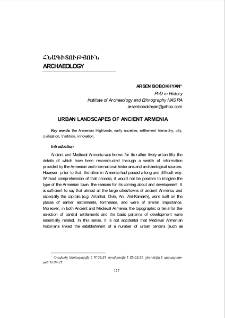Object
Title: Миграционные процессы и вопросы культурного взаимодействия в Закавказье в XII-VI ты с . до н.э.
Հրապարակման մանրամասներ:
«Բանբեր հայագիտության» միջազգային գիտական հանդեսը լույս է տեսնում 2013 թվականից։
Ամսագրի կամ հրապարակման վերնագիր:
Բանբեր հայագիտության = Вестник Арменоведения = Review of Armenian studies
Հրապարակման ամսաթիվ:
Համար:
ISSN:
Պաշտոնական URL:
Լրացուցիչ տեղեկություն:
Մանկո Վ., Չխատարաշվիլի Գ., Manko V., Chkhatarashvili G.
Այլ վերնագիր:
Միգրացիոն գործընթացները և մշակութային փոխազդեցության խնդիրներն Անդրկովկասում ք.ա. XII-VI հազարամյակներում ; Migration Processes And Issues Of CulturalInteraction In Transcaucasia IN THE XII—VI Millenia B.C.
Աջակից(ներ):
Գլխավոր խմբագիր՝ Պ. Ա. Չոբանյան (2013-2017) ; Ա. Խառատյան (2017-)
Ծածկույթ:
Ամփոփում:
Authors propose a new model of Neolithization of Transcaucasia. The transition to the Neolithic way of life was prepared by a series of population migrations from the territory of the Near and Middle East. Those migrations did not occur in the Neolithic, but at the end of the Plestocene and at the beginning of the Holocene, that is, on the eve of the Neolithic. The immigrants, apparently, sought to continue the development of traditional forms of economy in new territories. Such migrations are associated with the relocation of carriers of cultural traditions of Zarzian, Trialetian, M’lefaatian and Chayonu. The immigrants did not lose ties with their mother territories, which eventually led to the spread of Neolithic innovations in material culture and economy. Almost all migrant industries have become the basis for the formation of Neolithic cultures in Transcaucasia. The Zarzian migration occurred at the end of the Pleistocene and opened the way for the Trialetian migration of the late X-IX millennium BC. On the basis of the Trialetia complexes, the Chokh culture was formed. The migration of the M’lefaatian population led to the emergence of the Kobuleti industry. It became the basis for the Odishi Neolithic culture. The migration of carriers of Chayonu traditions led to the emergence of Neolithic cultures in Armenia. Thus, at the end of the Pleistocene and at the beginning of the Holocene, we observe large-scale migrations. The development of the Neolithic is accompanied by diffusion processes of small population groups, which carry out shuttle movements between Transcaucasia and the starting points of migration. These movements of small groups of the population ensured the creation of a single information space within which Neolithic innovations spread.
Հրատարակության վայրը:
Երևան
Հրատարակիչ:
Ձևաչափ:
Նույնացուցիչ:
oai:arar.sci.am:273110
Դասիչ:
Բնօրինակի գտնվելու վայրը:
ՀՀ ԳԱԱ Հիմնարար գիտական գրադարան
Object collections:
Last modified:
Feb 6, 2025
In our library since:
Jul 15, 2021
Number of object content hits:
67
All available object's versions:
https://arar.sci.am/publication/297571
Show description in RDF format:
Show description in OAI-PMH format:
-
Բանբեր հայագիտության = Вестник Арменоведения = Review of Armenian studies
-
Բանբեր հայագիտության, 2013
-
Բանբեր հայագիտության, 2014
-
Բանբեր հայագիտության, 2015
-
Բանբեր հայագիտության, 2016
-
Բանբեր հայագիտության, 2017
-
Բանբեր հայագիտության, 2018
-
Բանբեր հայագիտության, 2019
-
Բանբեր հայագիտության, 2020
-
Բանբեր հայագիտության, 2021
-
Բանբեր հայագիտության, 2021, 1
- Կազմ; Խմբագրական խորհուրդ; Գիտական խորհուրդ
- Բովանդակություն
- On the History of the Armenian Sanctuaries of Absheron Peninsula (an overview)
- Политико- правовой анализ «Трехстороннего заявления о прекращении огня в Нагорном Карабахе» 10 ноября 2020 года
- История мученичества святых Рипсимеанок в Европейской литературе путешествий
- Իրանահայության ժողովրդագրության հարցերը 2000-ական թվականներին
- The Ashrafs In The Ottoman Parliament
- Հայերը Թուրքեստանի քաղաքներում
- «Նաւդ ի բեռաց թեթեւացոյ...»Մկրտիչ Նաղաշն ու կաթողիկոսական աթոռը
- Urban Landscapes Of Ancient Armenia
- Миграционные процессы и вопросы культурного взаимодействия в Закавказье в XII-VI ты с . до н.э.
- Роль и значение творчества Комитаса для армянской культуры
- Le Genocide Armen I En EtLes Heroiques Batailles D’autodefense Des Armeniens De La Cilicie (Essai Historique Et Philologique)
- H. Tumanyan: Evaluations By Russian Intellectuals Of The Time
- «Անդաստանը» ազգային-մշակութային աշխարհայացքի ընդլայնման ծիրում
- Arshak Safrastyan On The Treaty Of Sevres AndThe Arbitration Of President W. Wilson Concerning The Frontier Question
- Karen Khachatryan, Hamo Sukiasyan, Gegham Badalyan. Annexation Of The Armenian Territories To Turkey And Soviet Azerbaijan In The 1920s And 1930s
- Վաստակաշատ հայագետի արգասաբեր ուղին
-
Բանբեր հայագիտության, 2021, 2
-
Բանբեր հայագիտության, 2021, 3
-
Բանբեր հայագիտության, 2021, 1
-
Բանբեր հայագիտության, 2022
-
Բանբեր հայագիտության, 2023
-
Բանբեր հայագիտության, 2024
-
Բանբեր հայագիտության, 2025
-
Բանբեր հայագիտության, 2013
| Edition name | Date |
|---|---|
| Манько, Валерий, Миграционные процессы и вопросы Культурного взаимодействия в Закавказье в XII-VI ты с . до н.э. | Feb 6, 2025 |





